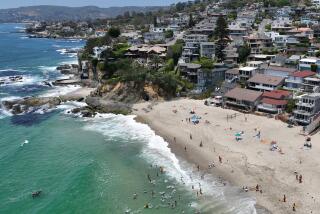Nantucketers Grumbling Over Traffic Rumblings
- Share via
NANTUCKET, Mass. — When T. Michael Burns signed on last year as this quaint island’s transportation planner, “I was told there’s three things you can’t touch: The cobblestones, the monuments in the street--and you’re not going to put a stoplight on Nantucket.”
Too many cars are clogging this whippet of land in the Atlantic Ocean--14 miles long and just 3 1/2 miles across at its widest point--putting Burns and a contentious committee of islanders at odds as they struggle to solve the traffic dilemma while preserving Nantucket’s image as an oasis of laid-back charm.
The issue is not just the number of vehicles but also their size and their owners’ city driving habits. Last week, Burns thought he would try a little experiment by installing speed bumps on York Street.
“Speed bumps!” exclaimed Linda Williams, the island’s acting zoning commissioner. “I’ve got a problem with that. It’s just not Nantucket.”
Then again, neither is gridlock--in theory. But every summer day, when the ferry docks at South Street, sport-utility vehicles from New Jersey jostle SUVs from Connecticut, New York, Pennsylvania and Rhode Island. In some cases, Mom, in a spiffy headband with matching shoes and handbag, drives one vehicle; Dad, in golf gear, pilots another; and teens Muffy and Biff might follow in a third.
When wealthy vacationers descend on Nantucket, where oceanfront rentals can go for $25,000 per week, the summer population quintuples, to around 50,000. The number of cars soars to about half that. Then there are the bicycles, motor scooters and delivery trucks that arrive by ferry from the mainland.
This summer, tourism is down about 5% over last year, but the car total is up by about that.
“It has gotten out of hand,” said Nantucket Selectman Matt Fee, who owns a bakery and sandwich shop. “There are too many vehicles and not enough roads.”
Here, Fee said, “we’re selling beaches, we’re selling peace and quiet. We’re selling a beautiful summer resort at a slower pace than they have at home. We’re not selling traffic jams and cars parked on sidewalks.”
Simple excursions that once took five minutes now last half an hour. Main Street, renowned for its cobblestones, often resembles a parking lot. The glut of vehicles on narrow roads laid out several centuries ago is made worse by the mammoth proportions of the abundant Lincoln Navigators, Chevrolet Suburbans and Cadillac Escalades.
“The traffic this year was terrible. On Main Street, sometimes it was bumper to bumper,” said Cathy Day, a Boston-area real estate agent who recently vacationed here with her family. “I know people who own houses on the island and leave a car there. Then when they come over, they bring another one.”
Moira Sullivan, a recent transplant from the California wine country, said the car density on Nantucket was so daunting that “it’s starting to remind me of St. Helena in the summer.”
And islanders also complain that, along with their cars, visitors import their urban driving proclivities. With frozen cappuccino in one hand, cell phone in the other, visitors window shop on Main Street while navigating the cobblestones, islanders lament. Multiple family members make multiple trips in multiple cars, the year-round residents decry. And too many people just drive too fast.
“If they drove that way at home,” said Williams, the zoning administrator, “they’d be a grease spot.”
For more than two years, a committee has debated possible solutions. A Bermuda-inspired bill to impose a vehicle-permitting system hit a brick wall with state legislators, who argued that Nantucket is a county, not a country, and therefore must follow the open registration rules of the rest of the commonwealth.
A cute, town-owned shuttle bus circles the island, and guest houses have begun sending out notices advising prospective visitors to leave their cars at home.
There is talk of building new roads, or paving some rustic dirt pathways. A plan for a new traffic rotary was quashed because it would have meant sacrificing a 300-year-old tree.
After months of study, a Boston consulting firm found that five of 10 intersections performed at a “failed level of service,” meaning that vehicles waited more than 50 seconds to pass through, said Christine Silverstein, head of Nantucket Sustainable Development Corp., an island nonprofit.
As part of the Nantucket mystique, visitors already are putting up with $20 hamburgers and gasoline that costs $2.25 a gallon. The Chamber of Commerce has never fully calculated just how generously the summer influx enriches the island’s coffers. But at last count, it was estimated at $300 million to $400 million.
But sooner or later, Silverstein and others contend, the congestion will catch up with Nantucket, degrading the experience of an island that markets itself as an antidote to the madness of the mainland.
“Our economy is character-based,” she said. “It’s not just the beaches, it’s the feel of everything else. I think visitors are not going to come because they are stuck in traffic wherever they go on the island.”
To combat that eventuality, the island’s weekly newspaper editorialized this year in favor of a stoplight--a solution that many islanders consider the ultimate threat to Nantucket’s quirky personality. Resistance to the idea is high.
A stoplight “is seen as this tremendous evil,” Williams said. The hurdle “over which no one wants to leap,” echoed Silverstein.
So when he is not sneaking out to secretly install speed bumps, traffic planner Burns has come up with a stock response when asked about the island’s car problem: “I tell people we’re working on it.”
Then Burns--who left Tempe, Ariz., to work on Nantucket--makes the five-minute walk between his home and his office.
“Sure we have some traffic here,” he said. “But compared to Arizona, this is paradise.”
More to Read
Sign up for Essential California
The most important California stories and recommendations in your inbox every morning.
You may occasionally receive promotional content from the Los Angeles Times.













